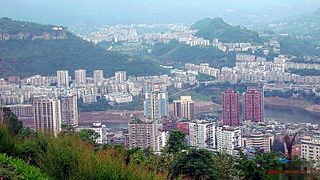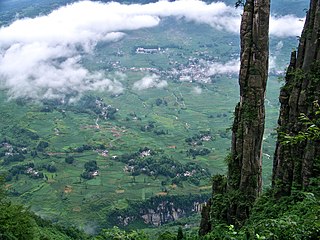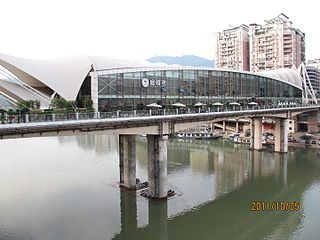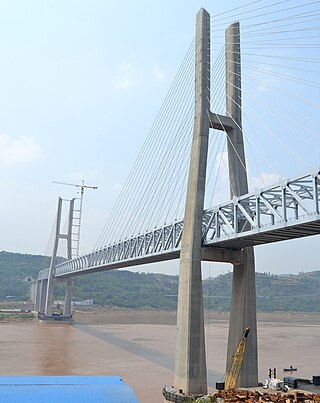
Wanzhou District is Chongqing's second most populated urban core area on the upper reaches of the Three Gorges of the Yangtze River in China. It is currently governed as a district of Chongqing Municipality, bordering Sichuan to the northwest and Hubei to the southeast. It was formerly known as Wanxian or Wan County. Prior to Chongqing's formation as a direct-controlled municipality, Wanzhou was part of Sichuan province. The urban core of Wanzhou is 228 km (142 mi) away from Chongqing's city proper.

Yichang, alternatively romanized as Ichang, is a prefecture-level city located in western Hubei province, China. Yichang had a population of 3.92 million people at the 2022 census, making it the third most populous city in Hubei. The city is famous for the Three Gorges, the Three Gorges Dam and the Gezhouba Dam, all three of which are located in Yiling District, one of the city's districts.

Enshi Tujia and Miao Autonomous Prefecture is located in the mountainous southwestern corner of Hubei province, People's Republic of China. It forms Hubei's southwestern "panhandle", bordering on Hunan in the south and Chongqing Municipality in the west and northwest. The Yangtze River crosses the prefecture's northeastern corner in Badong County.

Dazhou is a prefecture-level city in the northeast corner of Sichuan province, China, bordering Shaanxi to the north and Chongqing to the east and south. As of 2020 census, Dazhou was home to 5,385,422 inhabitants whom 1,850,869 lived in the built-up area made of 2 urban districts.

Lichuan is a county-level city of the Enshi Tujia and Miao Autonomous Prefecture, in southwestern Hubei province, People's Republic of China, located 52 kilometres (32 mi) west of Enshi City, the prefecture seat. It borders Chongqing Municipality to the southwest, west, and north. It has 750,670 inhabitants.

The Xiangyang–Chongqing railway or Xiangyu railway (襄渝铁路), also known as the Xiangfan-Chongqing railway and Xiangyu line (襄渝线), is a single-track electrified railroad in central China between the cities of Xiangyang, formerly known as Xiangfan, and Chongqing. The short form name for Chongqing is Yu (渝) and the railway is named after the two cities. It has a total length of 895.3 km and passes through Hubei, Shaanxi and Sichuan province, and Chongqing municipality. Major cities along route include Shiyan, Ankang, Dazhou and Guang'an.

The Shijiazhuang–Wuhan high-speed railway, or Shiwu passenger railway, is an 840 km (520 mi) high-speed rail line operated by China Railway High-speed between Shijiazhuang and Wuhan, the provincial capitals of Hebei and Hubei, respectively. Construction commenced in October 2008, with a total investment of 116.76 billion yuan. The design speed is 350 km/h (220 mph). It is part of the Jingguang passenger-dedicated line, a high-speed railway connecting Beijing and Guangzhou, which runs parallel to the older conventional Jingguang Railway.

Yichang East railway station, formerly Huayan railway station, is a railway station in Yichang City, Hubei Province, China. It is the junction of two sections of the Shanghai–Wuhan–Chengdu high-speed railway (Huhanrong): the Hanyi Railway, going east to Hankou (Wuhan), and the Yiwan Railway going west to Lichuan and Wanzhou. The Hanyi Railway is operated by the Wuhan Railway Bureau.
Liangwu railway station is a railway station currently being built in Liangwu Township, Lichuan City, Enshi, Hubei Province in China. It will be the junction station where the Yuli Railway (Chongqing-Lichuan) will join the Yiwan Railway (Yichang-Wanzhou).

Lichuan railway station is a railway station in Lichuan City, Enshi Tujia and Miao Autonomous Prefecture, Hubei Province of the People's Republic of China. It is an important junction point on the Huhanrong Passenger Dedicated Line, which crosses China from Shanghai on the east coast to Chongqing and Chengdu in the central province of Sichuan. Here the Yuli Railway joins with the Yiwan Railway .

Wuhan–Yichang railway, or Hanyi railway, is a 291-kilometre (181 mi) long higher-speed railway between Hankou and Yichang, in Hubei province, China. The railway forms a section of the Huhanrong passenger-dedicated line from Shanghai to Wuhan to Chengdu. The Hanyi Railway was completed in spring 2012 and started commercial operations on July 1, 2012. Adjacent high-speed rail sections, the Hefei–Wuhan railway to the east and the Yichang−Wanzhou railway to the west, opened respectively in April 2009 and December 2010.

The Chongqing–Lichuan railway, or the Yuli railway is a railway connecting central Chongqing with the Hubei city of Lichuan. The 244 km (152 mi) long railway, connecting Chongqing North railway station with the Lichuan Station on the Yichang–Wanzhou railway, is a section of the Shanghai–Wuhan–Chengdu passenger railway, which extends to Wuhan, Nanjing, and Shanghai.

Shanghai–Wuhan–Chengdu passenger-dedicated line or Huhanrong PDL, is a fully completed rail corridor in China. It is operated by CR Shanghai Group, CR Wuhan Group and CR Chengdu Group. The Chinese name of the railway line, Huhanrong, is a combination of the abbreviations for Shanghai, Wuhan, and Chengdu, three major cities along the line.

The Shanghai–Chengdu Expressway, designated as G42 and commonly referred to as the Hurong Expressway is an east–west bound expressway that connects the eastern metropolis of Shanghai to Chengdu, the capital city of Sichuan. The expressway passes through six provinces and serves major cities such as Suzhou, Wuxi, Changzhou, Nanjing, Hefei, Wuhan, and Yichang. The eastern terminus of G42 is at the Wuning Road Interchange of Shanghai Middle Ring Road. At its western terminus, the expressway intersects the East 3rd Ring Road and connects East Erxianqiao Road in Chenghua District, Chengdu. The expressway spans 1,960 km (1,220 mi) in length.
The Hankou–Danjiangkou railway or Handan railway, is a railroad in central China between Wuhan and Danjiangkou in Hubei Province. The line is 411 km (255 mi) long and follows the Han River from Wuhan's Hankou District north to Danjiangkou near the border with Henan Province. The line was built from 1958 to 1966 and double-tracked in 2009. Major cities and towns along route include Wuhan, Anlu, Suizhou, Zaoyang, Xiangyang, Laohekou and Danjiangkou.

Wanzhou railway station is the western terminus of the Yichang–Wanzhou railway in Wanzhou District, Chongqing. This is a branch off the Shanghai–Wuhan–Chengdu High-Speed Railway, with most services divert south to Chongqing on the Yuli Railway at Lichuan. High-speed rail services are available to eastern destinations in neighbouring Hebei province and beyond. Major destinations being Wuhan and Yichang. Conventional rail connections extend to the west, to Dazhou and beyond to Chengdu and other Sichuan cities via the Dacheng Railway and Chongqing via the Xiangyu Railway. The station was opened to high-speed traffic on December 22, 2010.

Dazhou–Chengdu Railway or Dacheng Railway, is a double-track, electrified railroad in Sichuan Province of southwest China. The railway is named after its two terminal cities Chengdu and Dazhou. The line has a total length of 403 km (250 mi) and opened in 1997. Other cities and towns along the route include Suining and Nanchong. The line is owned and operated by the Dacheng Railway Company Limited, a 70-30 joint venture between the Ministry of Railways and Sichuan Provincial Government.
The Shanghai–Chongqing–Chengdu high-speed railway is a high-speed rail line under construction in China. The Chinese name of the railway line, Huyurong, is a combination of the abbreviations for Shanghai, Chongqing, and Chengdu. It will run in an east-west direction largely parallel to the Yangtze River, connecting the cities of Shanghai, Nanjing, Hefei, Wuhan, Chongqing and Chengdu.
The Yichang–Xingshan high-speed railway, also referred to in Chinese under the acronym Yichang-Zhengwan high-speed railway connection line, is a high-speed railway under construction between Yichang on the Wuhan–Yichang railway and Xingshan on the Zhengzhou–Wanzhou high-speed railway in Hubei province, China. It will form part of the Shanghai–Chongqing–Chengdu high-speed railway. The total length of the line is 109.38 km (67.97 mi), and there are 3 stations on the whole line. It is a line connecting the Wuhan–Yichang railway and the Zhengzhou–Wanzhou high-speed railway. The line will run from Yichang East station via the Changgangling area and Xiabaoping station to Xingshan station. In addition, this line is also planned to be connected with Yichang North railway station and the Wuhan–Yichang high speed railway, also currently under construction. The estimated total investment of the project is 18.15 billion yuan, the construction period is 5.5 years, the design speed is 350 km/h (220 mph), and 94.37% of the main line will run on bridge or through tunnel. It is expected to be officially completed and opened to traffic in 2024. After the completion of the line, combined with the Zhengzhou-Wanzhou HSR to form a new east–west high-speed railway route in the Sichuan-Chongqing area, the Wuhan–Chongqing route will be shortened from the current fastest service of 5 hours and 54 minutes to about 3 hours, and Wuhan–Chengdu services will take only 5 hours. At the same time, journeys between Yichang and Beijing will be shortened from the current 8 hours to about 4.5 hours.

















